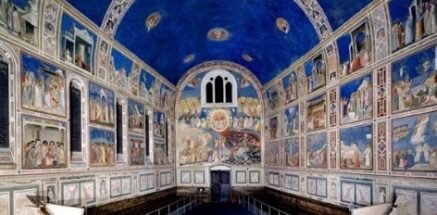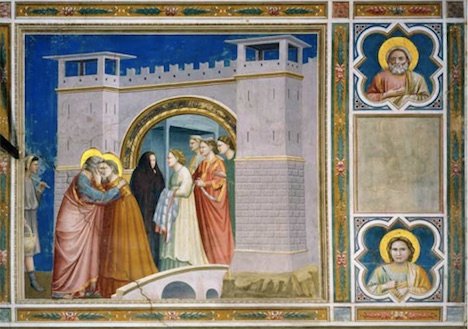
After Dante was exiled from Florence in 1302, one of the cities that he visited was Padua. His good friend Giotto was busy painting the walls of my favorite decorative space in the world – the Scrovegni Chapel.

“Scrovegni Chapel”, Giotto, 1303-1305, Padua, Italy
In addition to being the first painter to successfully reintroduce naturalism into medieval painting (see last blog “Giotto and the return to naturalism”), Giotto was also allegedly a rather virile man, having possibly fathered as many as 8 children.
One day, while Dante was hanging around the chapel watching his friend paint, he asked Giotto why his painted figures were all so beautiful, while his children were all so ugly. Giotto’s quick response was that he painted his figures by day… and made his children by night!!!!
Now, if a buddy and I were throwing back a couple of beers on a Friday night, this type of talk could at the least be tolerated. But one does not expect Dante Alighieri (who was no real looker himself, see above) and Giotto di Bondone, two of the greatest artists that our species has ever produced, to be slinging “tavern talk” back and forth. Regardless of whether the exchange ever actually took place, the meaning of the anecdote is clear – that this type of “regular guy” or popularist philosophy is clearly reflected in the art of both men.
Dante revolutionized medieval literature by writing his great epic trilogy, the Divine Comedy, in the vernacular – or the language spoken by the ordinary people of a particular region, which in the case of Dante, was Tuscany.
Most people misinterpret this fact as meaning that more people could therefore read the Divine Comedy. This was, in fact, not the case as the literacy rate of Medieval Europe remained staggeringly low. But it did mean that more people could understand the Divine Comedy at a time when nearly everything was written in Latin. If the literate 3 or 4 out of every 10 people read to the illiterate remainder in Latin, it would make no difference as the remainder did not comprehend Latin either. But if they were read to in the Tuscan vernacular, then they could understand, and suddenly literature no longer belonged exclusively to the clerical caste.
And as Dante did in literature, so too did Giotto in the visual arts, as he made biblical stories seem human by introducing what I call the “Visual Vernacular”.

“Meeting at the Golden Gate”, Giotto, Scrovegni Chapel, Padua, Italy
In his Meeting at the Golden Gate, Giotto has Saints Joachim and Anne, parents of the BVM (see Blessed Virgin Mary), celebrate the news of Anne’s pregnancy by hugging and kissing. This might seem like rather predictable reaction to the modern viewer, but not so in the medieval world. In fact, years later, Giotto’s pupil and godson, Taddeo Gaddi, painted the same scene in Florence. But before painting the two saints engaged in a hug and a kiss, he asked the archbishop of Florence for permission. And that permission was denied!
The thought of saints kissing was considered indecent. So instead of doing what would be most natural for any couple upon discovering that after long years of waiting, their life-long dream of having a child had come true, Gaddi’s saints celebrate by rubbing forearms and bumping halos! (see below)

“Meeting at the Golden Gate”, Taddeo Gaddi, 1333, Baroncelli Chapel, Santa Croce, Florence
So why was Giotto able to get away with it? To start with, he was not the type of personality to ask permission first. But I also believe that it was because Giotto’s story of the BVM was such a human one, that viewers may have forgotten that the characters were actually holy.

“Birth of the BVM”, Giotto, Scrovegni Chapel, Padua, Italy
I also find that the older I get, the more I appreciate Giotto. In his Birth of the Virgin Mary, notice how the elderly St. Anne reaches enthusiastically towards her larvae-looking newborn daughter. A detail that is not lost on any husband, including myself. After having twice witnessed my wife go through hours of excruciating labor, which, I am convinced, would kill any man, I also saw all the pain and fatigue magically disappear as our children were respectively put into her arms.
At the bottom of the painting, we see a midwife clearing out the gunk from the BVM’s nostrils. The importance of such a detail should not be overlooked.
This is the birth of the BVM that we are talking about. One imagines that she flew out of Anne’s womb with full superpowers at the ready!
Instead, Giotto gives us just an ordinary birth, the details of which, if he had indeed fathered 8 times, would have been familiar to him. This includes the exchange in the doorway to the left where the girl outside seems to be asking the midwife inside that eternal question – boy or girl!
And lastly, in his Presentation of the Virgin, instead of showing a confident and assertive miniature woman strutting up the temple stairs as if they were a catwalk (as most artists before him did), Giotto instead shows us a timid and unsure adolescent whose reassuring mamma nudges her up those scary steps.
Terrifying memories of my own first days at kindergarten come flooding back, as I seem to recall the use of a crowbar to detach me from my mother’s legs…
And again, I find myself forgetting that Giotto’s paintings are actually about gods and saints, who seem to be just as imperfect as you and me. As a good friend of mine once said, you only have to be human to appreciate Giotto…



















